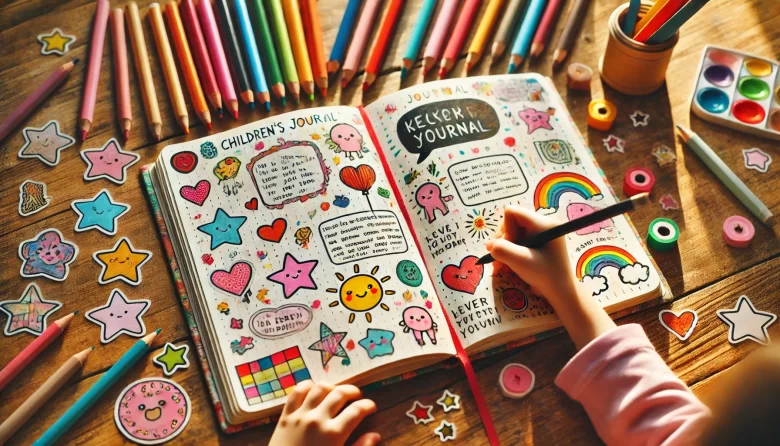Encouraging children to keep a journal is a fantastic way to stimulate their creativity, improve their writing skills, and help them express their emotions. A personal journal allows kids to explore their thoughts, tell stories, and develop a lifelong love for writing.
In this article, we’ll explore the benefits of journaling for children, how to create an engaging journal, and fun ways to make this activity a daily habit.
The Benefits of Journaling for Children
Journaling is more than just writing—it’s a tool for self-expression and cognitive development. Here are some of the key benefits:
Enhances Writing and Language Skills
Writing regularly helps children practice sentence structure, improve vocabulary, and develop their storytelling abilities.
Boosts Creativity
A journal is a space where children can draw, invent stories, and create imaginative characters. It encourages out-of-the-box thinking and artistic expression.
Improves Emotional Expression and Confidence
Writing about their day or emotions helps children process their feelings, building emotional intelligence and confidence in expressing themselves.
Encourages Self-Reflection
Journaling teaches kids to reflect on their actions, experiences, and goals, helping them develop a sense of identity and awareness.
Creates Lasting Memories
A journal serves as a keepsake where children can look back and see how much they’ve grown and what they’ve experienced over time.
How to Create a Fun and Engaging Children’s Journal
Setting up a journal for your child can be an exciting project. Follow these steps to create one that will keep them motivated.
Choose the Right Type of Journal
The journal can be:
- A Notebook or Sketchbook – Perfect for kids who love to write and draw.
- A Binder with Loose Pages – Allows flexibility to add drawings, photos, or different writing styles.
- A Digital Journal – Apps or simple word processors can be great for tech-savvy kids.
Choose a format that suits your child’s preferences.
Make It Personal and Fun
Encourage your child to decorate their journal to make it feel special. They can:
- Design a colorful cover with their name and stickers.
- Use markers, washi tape, and drawings to make it unique.
- Create a “dedication page” explaining what their journal is about.
Provide Writing Prompts and Creative Ideas
Some children may struggle with what to write, so offering writing prompts can help spark ideas. Here are some fun prompts:
- “What was the best thing that happened today?”
- “If you had a superpower, what would it be?”
- “Describe your dream adventure.”
- “Write a letter to your future self.”
- “Create a new holiday. What do people do to celebrate it?”
For younger kids, encourage a mix of drawings and short sentences.
Encourage Different Forms of Expression
A journal doesn’t have to be only about writing. Let your child:
- Draw pictures to illustrate their day or emotions.
- Paste photos or magazine cutouts to create collages.
- Make lists of their favorite things, such as books, movies, or dream vacations.
Make Journaling a Routine
Help your child make journaling a regular habit by:
- Setting aside a specific time (before bed, after school, or during quiet time).
- Encouraging them to write at least a few sentences daily.
- Making it a fun, pressure-free activity rather than a chore.
Be Supportive but Give Them Privacy
Children should feel free to express themselves without worrying about being judged. If they want to share their entries, listen and ask questions, but also respect their privacy if they prefer to keep it personal.
Incorporate Positive Reinforcement
Praise your child’s effort rather than focusing on spelling or grammar. Celebrate their creativity and encourage them to keep going.
Fun Journaling Activities to Try
If your child needs variety, try these interactive journaling ideas:
Gratitude Journal
Encourage your child to write three things they are grateful for each day. This helps develop a positive mindset.
Adventure Log
Let your child document special trips, outings, or family vacations with drawings, photos, and descriptions.
Dream Journal
Have them write or draw their dreams each morning. This can spark fun storytelling ideas.
Story Writing Challenge
Give your child the first sentence of a story and let them continue it in their journal.
Feelings Journal
Provide emotion-based prompts like:
- “What made you happy today?”
- “How did you handle a difficult situation?”
- “What is something you’re proud of?”
This helps children develop emotional awareness and problem-solving skills.
How to Keep Your Child Engaged in Journaling
If your child loses interest in journaling, try these strategies:
- Let them use different colors and materials to make journaling visually exciting.
- Write alongside them—keeping your own journal can set a good example.
- Use stickers, stamps, and fun accessories to make journaling interactive.
- Try themed journaling weeks, such as “Travel Week” (writing about imaginary trips) or “Animal Week” (stories about favorite animals).
- Introduce journaling buddies, where they share journals with a friend or family member.
Final Thoughts
Journaling is an excellent way for children to build writing skills, boost creativity, and express emotions in a healthy way. By making the process fun, engaging, and pressure-free, you can help your child develop a lifelong love for storytelling and self-reflection.
Encourage your child to see their journal as a safe space for their thoughts, dreams, and ideas. With the right approach, journaling can become one of their favorite activities!




